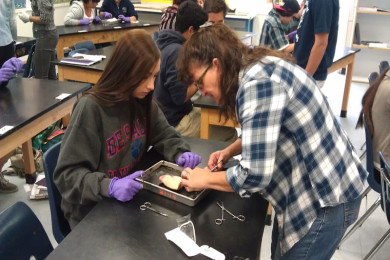Health Care Essentials
Nurse Practitioner Amy Bell assists senior Brooke Anderson suture her pig’s foot.
The past few weeks in the Health Care Essentials class, nurse practitioner Amy Bell has been visiting to not only educate the students about her career but also to give demonstrations and instructions on practical applications of health care.
In her first visit, Bell provided the class with an idea of the process of becoming a nurse practitioner and the details about the job. A nurse practitioner cares for patients throughout their lifetime and is the closest position to a physician without having to endure the time and monetary restrictions of medical school.
Many students in the class are considering careers in health care but may not know exactly which career they want to strive for or what position is best for them. Bell’s presentation opened the students’ to the nurse practitioner career and gave insight on the job requirements and responsibilities.
“After she came in, I felt like I knew more about the daily tasks of a nurse practitioner, and got a glimpse and hands on experience of exactly what she does, even though we only worked with oranges,” senior Rachel Terry said.
When she visited for a second time, she brought oranges, needles, and syringes to teach the class how to administer injections. Bell demonstrated the steps and technique, and then gave each group of four to five students three oranges with different labels. She also brought in four different “medications,” water, and a set of instructions for each group. The students were assigned to administer one of the orange patients with a measured dose of a specific medication, and needed to administer it correctly.
During her third visit, Health Care Essentials teacher Jennifer McCluan, who has taught the class for four years, bought pig’s feet for every two students and, using the school’s emergency surgical kits, the students learned the basics of suturing, or stitching, small incisions in the pig’s feet. Bell instructed and assisted students with the difficulties of working with the surgical string, tweezers, and the pig flesh. Students that were uncomfortable working with the pig’s feet sutured incisions in bananas instead.
Because of these presentations, interactive demonstrations, and visits by Bell, students have hands-on experience and are more informed about the responsibilities and expectations of being a nurse practitioner, and can choose to follow in the direction of a career in health care.
The past few weeks in the Health Care Essentials class, nurse practitioner Amy Bell has been visiting to not only educate the students about her career but also to give demonstrations and instructions on practical applications of health care.
In her first visit, Bell provided the class with an idea of the process of becoming a nurse practitioner and the details about the job. A nurse practitioner cares for patients throughout their lifetime and is the closest position to a physician without having to endure the time and monetary restrictions of medical school.
Many students in the class are considering careers in health care but may not know exactly which career they want to strive for or what position is best for them. Bell’s presentation opened the students’ to the nurse practitioner career and gave insight on the job requirements and responsibilities.
“After she came in, I felt like I knew more about the daily tasks of a nurse practitioner, and got a glimpse and hands on experience of exactly what she does, even though we only worked with oranges,” senior Rachel Terry said.
When she visited for a second time, she brought oranges, needles, and syringes to teach the class how to administer injections. Bell demonstrated the steps and technique, and then gave each group of four to five students three oranges with different labels. She also brought in four different “medications,” water, and a set of instructions for each group. The students were assigned to administer one of the orange patients with a measured dose of a specific medication, and needed to administer it correctly.
During her third visit, Health Care Essentials teacher Jennifer McCluan, who has taught the class for four years, bought pig’s feet for every two students and, using the school’s emergency surgical kits, the students learned the basics of suturing, or stitching, small incisions in the pig’s feet. Bell instructed and assisted students with the difficulties of working with the surgical string, tweezers, and the pig flesh. Students that were uncomfortable working with the pig’s feet sutured incisions in bananas instead.
Because of these presentations, interactive demonstrations, and visits by Bell, students have hands-on experience and are more informed about the responsibilities and expectations of being a nurse practitioner, and can choose to follow in the direction of a career in health care.

